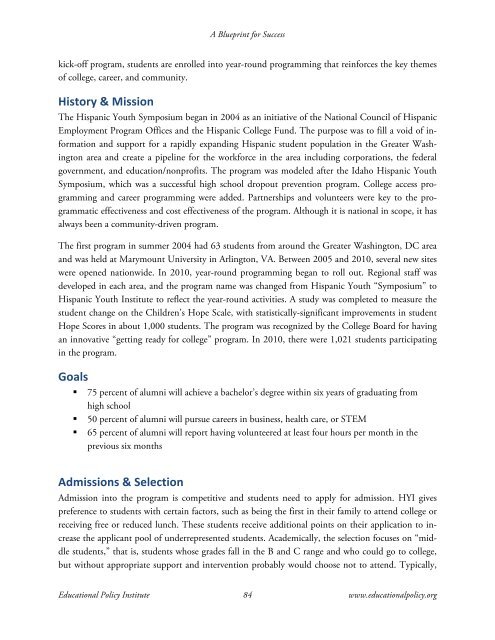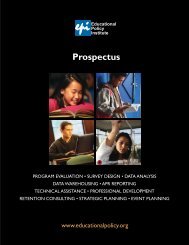A BluePrint for Success: Case Studies of Successful - Educational ...
A BluePrint for Success: Case Studies of Successful - Educational ...
A BluePrint for Success: Case Studies of Successful - Educational ...
You also want an ePaper? Increase the reach of your titles
YUMPU automatically turns print PDFs into web optimized ePapers that Google loves.
A Blueprint <strong>for</strong> <strong>Success</strong><br />
kick-<strong>of</strong>f program, students are enrolled into year-round programming that rein<strong>for</strong>ces the key themes<br />
<strong>of</strong> college, career, and community.<br />
History & Mission<br />
The Hispanic Youth Symposium began in 2004 as an initiative <strong>of</strong> the National Council <strong>of</strong> Hispanic<br />
Employment Program Offices and the Hispanic College Fund. The purpose was to fill a void <strong>of</strong> in<strong>for</strong>mation<br />
and support <strong>for</strong> a rapidly expanding Hispanic student population in the Greater Washington<br />
area and create a pipeline <strong>for</strong> the work<strong>for</strong>ce in the area including corporations, the federal<br />
government, and education/nonpr<strong>of</strong>its. The program was modeled after the Idaho Hispanic Youth<br />
Symposium, which was a successful high school dropout prevention program. College access programming<br />
and career programming were added. Partnerships and volunteers were key to the programmatic<br />
effectiveness and cost effectiveness <strong>of</strong> the program. Although it is national in scope, it has<br />
always been a community-driven program.<br />
The first program in summer 2004 had 63 students from around the Greater Washington, DC area<br />
and was held at Marymount University in Arlington, VA. Between 2005 and 2010, several new sites<br />
were opened nationwide. In 2010, year-round programming began to roll out. Regional staff was<br />
developed in each area, and the program name was changed from Hispanic Youth “Symposium” to<br />
Hispanic Youth Institute to reflect the year-round activities. A study was completed to measure the<br />
student change on the Children’s Hope Scale, with statistically-significant improvements in student<br />
Hope Scores in about 1,000 students. The program was recognized by the College Board <strong>for</strong> having<br />
an innovative “getting ready <strong>for</strong> college” program. In 2010, there were 1,021 students participating<br />
in the program.<br />
Goals<br />
75 percent <strong>of</strong> alumni will achieve a bachelor’s degree within six years <strong>of</strong> graduating from<br />
high school<br />
50 percent <strong>of</strong> alumni will pursue careers in business, health care, or STEM<br />
65 percent <strong>of</strong> alumni will report having volunteered at least four hours per month in the<br />
previous six months<br />
Admissions & Selection<br />
Admission into the program is competitive and students need to apply <strong>for</strong> admission. HYI gives<br />
preference to students with certain factors, such as being the first in their family to attend college or<br />
receiving free or reduced lunch. These students receive additional points on their application to increase<br />
the applicant pool <strong>of</strong> underrepresented students. Academically, the selection focuses on “middle<br />
students,” that is, students whose grades fall in the B and C range and who could go to college,<br />
but without appropriate support and intervention probably would choose not to attend. Typically,<br />
<strong>Educational</strong> Policy Institute 84 www.educationalpolicy.org




